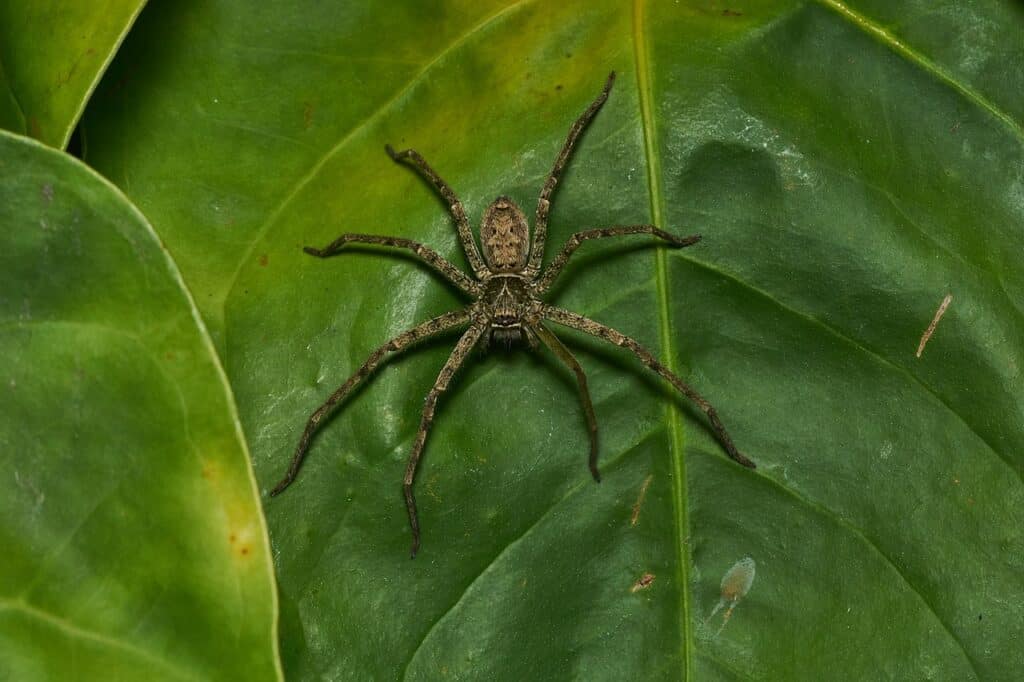Cane Spider
Heteropoda venatoria
Cane spiders don't spin webs to catch prey
Advertisement
Cane Spider Scientific Classification
- Kingdom
- Animalia
- Phylum
- Arthropoda
- Class
- Arachnida
- Order
- Araneae
- Family
- Sparassidae
- Genus
- Heteropoda
- Scientific Name
- Heteropoda venatoria
Read our Complete Guide to Classification of Animals.
Cane Spider Conservation Status
Cane Spider Facts
- Prey
- Insects, arachnids and small mammals
- Main Prey
- Butterfly, moths, and cockroaches
- Name Of Young
- Caterpillar
- Group Behavior
- Solitary
- Fun Fact
- Cane spiders don't spin webs to catch prey
- Most Distinctive Feature
- Cane spiders have dark spots on their legs
- Distinctive Feature
- Two rows of eyes arranged in front of the spider's head
- Other Name(s)
- Huntsman spider, house spider, big brown spider
- Average Spawn Size
- 100-400
- Habitat
- Sugarcane fields and other plantations
- Predators
- Reptiles, birds and rodents
- Diet
- Insectivore
- Lifestyle
- Nocturnal
- Favorite Food
- Insects
- Type
- Arachnid (spider)
- Common Name
- Cane spider
- Special Features
- Cane spiders can build double trap doors to catch prey
- Origin
- Tropical regions
- Location
- Hawaii and other tropical areas
- Nesting Location
- Underground
View all of the Cane Spider images!
The cane spider is a species native to Hawaii and other tropical regions of the world. Cane spiders do not spin the web as other spiders do. The giant spider hunts by patiently waiting and jumping on unsuspecting prey like cockroaches and other insects. It is known by different names in various regions. Although the cane spider can deliver a painful venomous bite, it is not considered dangerous.
Cane Spider Species, Types, and Scientific Name
Cane spider is the common name of a tropical spider species known by the scientific name Heteropoda venatoria. This spider species belongs to the family Sparassidae (the huntsman spiders). This group of spiders is known for their speed and active hunting lifestyle. The family has more than a thousand species, mostly found in temperate and tropical regions.
Cane spiders are frequently found in sugar cane fields. Their common name is a reference to this habit. The species also has several other common names depending on the specific region. It’s called the brown huntsman, large brown spider, giant crab spider, and banana spider. In Bermuda, this species is mainly found indoors. People call them house spiders (the same name as the southern house spider). They may also be referred to as wolf spiders.

The cane spider is also called the brown huntsman, large brown spider, giant crab spider, and banana spider.
©© 2017 Jee & Rani Nature Photography / CC BY-SA 4.0 via Wikimedia Commons – License
Appearance: How To Identify Cane Spider
The cane spider is a giant arachnid with a flat hairy body and thin, long legs. They come in varying shades of brown coloration, including tan, dark brown, reddish brown, and grayish brown. Adults have a body length of roughly 0.8 to one inch and can be between 2.8 and four inches wide. Like most spider species, females are typically larger than males. However, males have longer legs and more robust pedipalps (the antennae-like appendage close to the spider’s mouth).
The cane spider has eight eyes arranged in two rows on the front of its head. These eyes are its most distinctive feature. The portion right in front of the eyes, known as the clypeus, is white or yellowish. The spider’s carapace, located behind the eyes, has a wide band, typically brown in the female and white in the male.
Although they’re not very hairy, the spider has erectile setae (stiff hair-like structures) on its legs. Each of those setae has a dot of black pigment on it. Both males and females have thick, long legs, but males tend to have longer legs, while females have larger abdomens.

The cane spider (
Heteropoda venatoria) has eight eyes arranged in two rows on the front of its head.
©Protasov AN/Shutterstock.com
Habitat — Where To Find Cane Spider
Like many other species of huntsman spiders, Heteropoda venatoria is native to tropical regions of the world. They’re prevalent in Hawaii, where they’re found on all Hawaiian Islands. The spider is also present in Australia and South America. In North America, cane spiders are present in Florida, Georgia, Alabama, Louisiana, Texas, and California.
Cane spiders are common in agricultural settings, particularly in sugar cane fields which is why they’re called cane spiders. They may also be found in banana and avocado plantations. Cane spiders cannot survive in temperatures that are too cold. Their flat body allows them to squeeze into warm crevices and tight spaces when the temperature drops. They may also enter homes where they hide behind picture frames, furniture, and other tight spaces.

Cane spiders are common in agricultural settings, particularly in sugar cane fields, but may also be found in banana and avocado plantations.
©LiCheng Shih / Flickr – License
Evolution and History
Spiders have been evolving for at least 400 million years. The group’s ancestry can be traced back to a group of ancient arachnids that emerged from the water and adapted to life on the land about 380 million years ago. This means their existence predates the dinosaurs.
The earliest spiders had thin waist and abdominal segments. Unlike modern spiders, whose spinnerets (silk-producing structure) were at the end of their abdomen, ancient spiders had spinnerets on their abdomen. The oldest fossil of a spider ever found dates back to the Devonian.
The lifestyle of the earliest spiders is similar to that of present-day huntsman spiders like the cane spider. They were ground-dwelling predators feeding on cockroaches, silverfish, millipedes, and other primitive insects. Just like the cane spiders, these prehistoric spiders didn’t spin webs to catch prey. The silk they produced was mainly a protective covering for their eggs and to line their burrows. As time went by, the spiders evolved the ability to make trapdoors for catching prey.
Diet — What Do Cane Spiders Eat?
Cane spiders are insectivorous. They prey on insects like butterflies, moths, silverfish, and cockroaches. Unlike other spider species that spin webs and wait for prey to get caught in them, cane spiders and other huntsman spiders hunt prey directly.
The spider is nocturnal. It lies in wait or stalks prey to capture them. Once it captures prey, the spider injects venom into the prey and paralyzes it. In some tropical regions, people welcome cane spiders into their homes because of the arachnid’s ability to effectively control pest insects. Due to its large size and venom, this spider may also be able to prey on spiders and bats.
What Eats Cane Spiders?
Cane spiders have a few natural predators too. Their common predators include birds, large reptiles, and insectivorous rodents. The animal can also deliver a venomous sting to protect itself against predators. However, it is not very aggressive and is unlikely to attack humans or pets.
Prevention — How To Get Rid of Cane Spider
Cane spiders are not only safe to have in the house, but they may also assist in reducing insect populations. They feed on unwanted insects that congregate in dark and obscure places throughout the home. They won’t leave a mess in your house like other spiders because they don’t spin webs.
If you come into a cane spider tucked away in a quiet corner of your home, you might leave it there. However, if you wish to get rid of the cane spider because of allergies or other reasons, there are various options to try. You can set spider traps in high-traffic areas; these can be sticky glue traps or any other type of simple spider trap. Organic products such as peppermint oil may also repel this arachnid. You only need to add it to a spray bottle of water and then spritz it around. Store-bought insecticides may also be effective for getting rid of cane spiders.
Related Animals
View all 235 animals that start with CCane Spider FAQs (Frequently Asked Questions)
Are cane spiders dangerous?
No, cane spiders are not dangerous. They pose no threat to humans and aren’t violent. They prefer to spend their days in isolation. Although they are venomous, the shy nature of cane spiders makes it unlikely that they’ll ever bite anyone. The spider will most likely run and hide if discovered. In the unlikely event that you are bitten by one, the venom will only give you a mild headache.
How many legs does a cane spider have?
Cane spiders have eight legs. They also have an extra appendage called the pedipalp close to their mouth. This mainly serves sensory purposes.
.
How do you identify a cane spider?
The cane spider is a large and hairy arachnid. It is typically brown but may also be tan, reddish-brown, or gray. On average, this creature is about 0.75 to one inch tall with a leg width of up to five inches. Cane spiders are distinguished by their large, stout legs coated with black dots.
Are cane spiders aggressive?
Cane spiders rarely bite, and they’d rather flee than defend themselves. Despite this, the spider can occasionally bite and inject venom if provoked. The bite from the spider is minor and rarely causes any severe reaction.
Thank you for reading! Have some feedback for us? Contact the AZ Animals editorial team.
Sources
- Entomology & Nematology, Available here: https://entnemdept.ufl.edu/creatures/urban/spiders/giant_crab_spider.htm
- Spider Identifications, Available here: https://spideridentifications.com/cane.html
- Journeying the Globe, Available here: https://www.journeyingtheglobe.com/cane-spiders-how-big-are-they

















